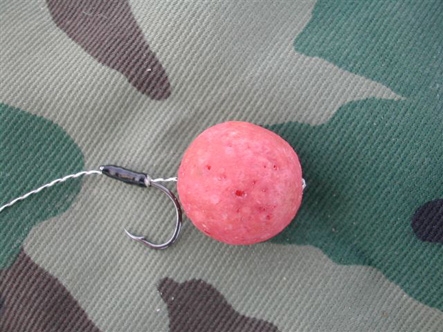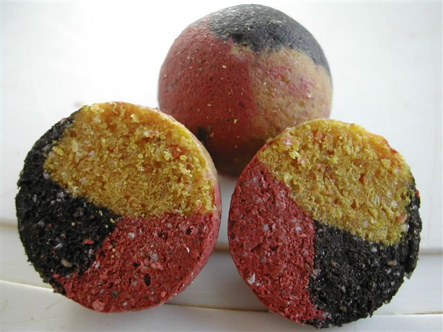|
Hair Rig
The Hair rig is a fishing method which allows a bait to be presented without sitting directly on the hook. It is mainly associated with boilies, but also works effectively with many other baits. The Hair-Rig became popular in the 1980s and was the joint invention of Len Middleton and Kevin Maddocks. It has been experimented with by many anglers, and has revolutionised carp fishing. At the beginning, natural hair from Len's wife's head was used because Len's own hair was far too curly. Hence the name, "hair-rig", to attach the bait to the hook after many 'tank test' experiments with captive carp carried out in Len's home. Before that all sorts of other materials were tried but human hair worked from the start. Human hair was very discreet and the carp seemed unaware of it when picking up bait attached to it, and also taking in the hook, but it was a little fragile. In tests, the carp The term carp (: carp) is a generic common name for numerous species of freshwater fish from ... [...More Info...] [...Related Items...] OR: [Wikipedia] [Google] [Baidu] |
Knotless Knot
The knotless knot is a hitch knot used to attach an eyed fishing hook to fishing line while leaving a length of line hanging below the hook. The extra length of line can then be used as the hair of a hair rig. Description The knotless is usually tied to a leader, rather than directly to the main line. The far end of the leader may already be baited or looped in preparation for bait, because the knot will be tied using the near end as the working end. The working end is passed through the hook eye from back to front (towards the hook point), wrapped tightly around itself and the hook shaft several times (down from the eye towards the bend of the hook), and finally passed once more through the eye back to front. External linksPhotographs showing how to tie the knotless knot [...More Info...] [...Related Items...] OR: [Wikipedia] [Google] [Baidu] |
Fishing Bait
Fishing bait is any bait (luring substance), luring substance used specifically to attract and fishing, catch fish, typically when angling with a fish hook, hook and fishing line, line. There are generally two types of baits used in angling: ''hookbaits'', which are directly mounted onto fish hooks and are what the term "fishing bait" typically refers to; and ''groundbaits'', which are scattered separately into the water as an "appetizer" to attract the fish nearer to the hook. Despite the bait's sole importance is to provoke a feeding response out of the target fish, the way how fish react to different baits is quite poorly understood. Fishing baits can be grouped into two broad categories: ''natural'' baits and ''artificial'' baits. Traditionally, fishing baits are natural food or prey items (live or dead) that are already present in the fish's normal diet (e.g. worms, insects, crustaceans and smaller bait fish), and such baits are both procured from and used within the same e ... [...More Info...] [...Related Items...] OR: [Wikipedia] [Google] [Baidu] |
Fishing Hook
A fish hook or fishhook, formerly also called an angle (from Old English ''angol'' and Proto-Germanic ''*angulaz''), is a hook used to catch fish either by piercing and embedding onto the inside of the fish mouth (angling) or, more rarely, by impaling and snagging the external fish body. Fish hooks are normally attached to a line, which tethers the target fish to the angler for retrieval, and are typically dressed with some form of bait or lure that entices the fish to swallow the hook out of its own natural instinct to forage or hunt. Fish hooks have been employed for millennia by fishermen to catch freshwater and saltwater fish. There is an enormous variety of fish hooks in the world of fishing. Sizes, designs, shapes, and materials are all variable depending on the intended purpose of the hook. Fish hooks are manufactured for a range of purposes from general fishing to extremely limited and specialized applications. Fish hooks are designed to hold various types of artific ... [...More Info...] [...Related Items...] OR: [Wikipedia] [Google] [Baidu] |
Boilies
Boilies are a type of artificial fishing bait made from boiled paste that usually consists of fishmeals, milk proteins, bird foods, semolina and soya flour, which are mixed with egg white as a binding agent. The mixture is then boiled to form hard, round balls that diffuse evenly and slowly in water, and additional flavourings and aromatic attractants are usually included in the mixture to enhance the olfactory appeal to the fish. The spherical shape also allows the baits to be catapulted accurately when fishing at distant waters. Though boilies are typically made and sold by large commercial suppliers, many anglers opt to make their own unique homemade boilies. Use Boilies are one of the most established carp fishing baits, available in a huge range of colours and flavours. Boilies come in all different shapes and sizes from tiny micro-boilies as small as to palm-sized balls as large as , which are more suited to waters where "nuisance fish" are present. The ability to pro ... [...More Info...] [...Related Items...] OR: [Wikipedia] [Google] [Baidu] |
Carp Fishing
Carp is a common name for various species of freshwater fish from the family (biology), family Cyprinidae that are native to Eurasia and sought after by some recreational fishermen. Certain carp species have been introduced species, introduced, with mixed results, to various other locations around the world, and even declared invasive species, invasive in certain regions. Izaak Walton said about carp in ''The Compleat Angler'', "The carp is the queen of rivers; a stately, good, and a very subtil fish; that was not at first bred, nor hath been long in England, but is now naturalisation (biology), naturalised". Managing recreational carp Good carp fishing can be found in many different types of water. Many find rivers to provide some of the most challenging, but rewarding, fishing. For rivers that connect directly with the ocean, the largest carp often reside in the stretch between the beginning of the tidal influence and where the salinity becomes intolerable to the carp. For exa ... [...More Info...] [...Related Items...] OR: [Wikipedia] [Google] [Baidu] |
Carp
The term carp (: carp) is a generic common name for numerous species of freshwater fish from the family (biology), family Cyprinidae, a very large clade of ray-finned fish mostly native to Eurasia. While carp are prized game fish, quarries and are valued (even pisciculture, commercially cultivated) as both food fish, food and ornamental fish in many parts of the Old World, they are considered trash fish and invasive species, invasive pest (organism), pests in many parts of Africa, Australia and most of the United States. Biology The cypriniformes (family Cyprinidae) are traditionally grouped with the Characiformes, Siluriformes, and Gymnotiformes to create the superorder Ostariophysi, since these groups share some common features. These features include being found predominantly in fresh water and possessing Weberian ossicles, an anatomical structure derived from the first five anterior-most vertebrae, and their corresponding ribs and neural crests. The third anterior-most pair ... [...More Info...] [...Related Items...] OR: [Wikipedia] [Google] [Baidu] |
Braided Fishing Line
Braided line was one of the earliest types of fishing line, and in its modern incarnations it is still very popular in some situations because of its high knot strength, lack of stretch, and great overall power in relation to its diameter. Background Braids were originally made from natural fibers such as cotton and linen, but natural fiber braids (with the very rare exception of braided silk) have long since been replaced by braided or woven fibers of synthetic materials like Dacron, Spectra or micro- dyneema into a strand of line. For these strands another term is used i.e. "carrier" as instance 8 strand braided fishing line is called an 8-carrier line. The braided line is visible underwater as compared to other lines. Due to this line's thin diameter, it can cause scratches and cuts on the angler's hands. Braided fishing lines have a low resistance to abrasion, and sharp objects can easily cut braided lines. Their actual breaking strength will commonly well exceed their po ... [...More Info...] [...Related Items...] OR: [Wikipedia] [Google] [Baidu] |
Fishing Sinker
A fishing sinker, plummet, or knoch is a weight used in conjunction with a fishing lure or hook to increase its rate of sink, anchoring ability, and/or casting distance. Fishing sinkers may be as small as for applications in shallow water, and even smaller for fly fishing applications, or as large as several pounds (>1 kg) or considerably more for deep sea fishing. They are formed into many different shapes for diverse fishing applications. Environmental concerns surround the usage of lead and other materials in fishing sinkers. Types A large variety of sinkers exist, whose specific use depends on the fish pursued, the environment, the current, and personal preference. Pyramid sinkers Pyramid sinkers are shaped like a pyramid and are used when it is desirable to anchor on the bottom of water bodies. They are attached to the terminal end of fishing line by loops of bra. Barrel or egg sinkers Barrel or egg sinkers are rounded and often bead-like with a narrow hole through wh ... [...More Info...] [...Related Items...] OR: [Wikipedia] [Google] [Baidu] |






